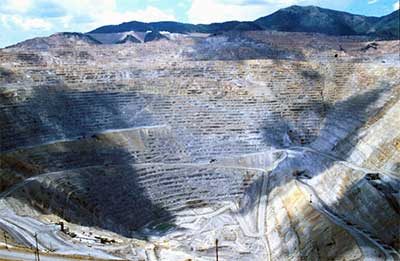1872 Mining Law 101

Rio Tinto's Bingham Canyon mine -- the largest open pit mine in North America.
Jurisdiction
The 1872 Mining Law governs hardrock mining on 350 million acres of public domain lands -- mostly in the West and Alaska. This constitutes more than 15% of all the land in the United States, or two thirds of the lands the federal government holds in trust for all Americans.
Public domain lands
Public domain lands consist of lands ceded to the federal government by the thirteen original states, plus "acquisitions" from Native Americans and foreign powers, and that have remained continuously in federal control since acquisition. For example, the Louisiana Purchase was all public-domain lands at one time.
Public domain lands do not include lands purchased or otherwise acquired by the federal government within the existing boundaries of the United States. For example, almost all National Forests east of the Mississippi River are not public domain lands, even though they are publicly owned lands.
Hardrock minerals
Practically speaking, hardrock minerals are mainly metals like gold, copper, and uranium. These metals constitute the vast majority of the value of mineral production governed by the Mining Law.
Specifically, hardrock minerals are actually defined by what they are not. When originally passed, the Mining Law governed all types of mining. Over the past 135 years, certain types of minerals have been removed from its jurisdiction -- including common materials like limestone, and all fuel minerals such as coal, oil and natural gas -- except uranium.
The right to mine -- staking a claim
Under the 1872 Mining Law, any U.S. citizen (including foreign companies with subsidiaries incorporated in the U.S.) can freely enter public domain lands to explore minerals. No permit needed. A small subset of public domain lands are excluded (e.g. National Parks and Wildernesses).
According to the Mining Law, once you discover a valuable hardrock mineral, you can then establish your right to mine that mineral by staking a claim. In practice, the federal government rarely checks to see if you've actually made a valuable discovery.
The right to mine -- the "highest and best use"
Once a claim is staked, the federal government has historically treated the claim as equivalent to a right to mine.
All other types of mine proposals (e.g. coal) on public lands must be weighed against other potential land uses before permittal.
But in the modern era, federal land management agencies have consistently argued that they cannot deny hardrock mining proposals because of the 1872 Mining Law -- federal land managers insist that, in the eyes of the Mining Law, mining is the highest and best use of public lands.
For more information:
- Earthworks: General Mining Law of 1872. An overview.
- Earthworks: The Mining Law of 1872: polluter of water, provider of pork. Fact sheet.
- Bureau of Land Managment: Mining claims. A section of the website of BLM's Wyoming office describes mining claims from the viewpoint of someone looking to stake a claim.
- Congressional Research Service: Mining on federal lands, May 3, 2001. Report. CRS is the research arm of the Library of Congress created directly to inform Congress.
- United States Statutes at Large (via Wikisource): Text of the 1872 Mining Law. As passed by the 42nd Congress. For minerals still under its jurisdiction, it still governs as passed in 1872.
Tagged with: mining claims, highest and best use, 1872 mining law
Follow Earthworks